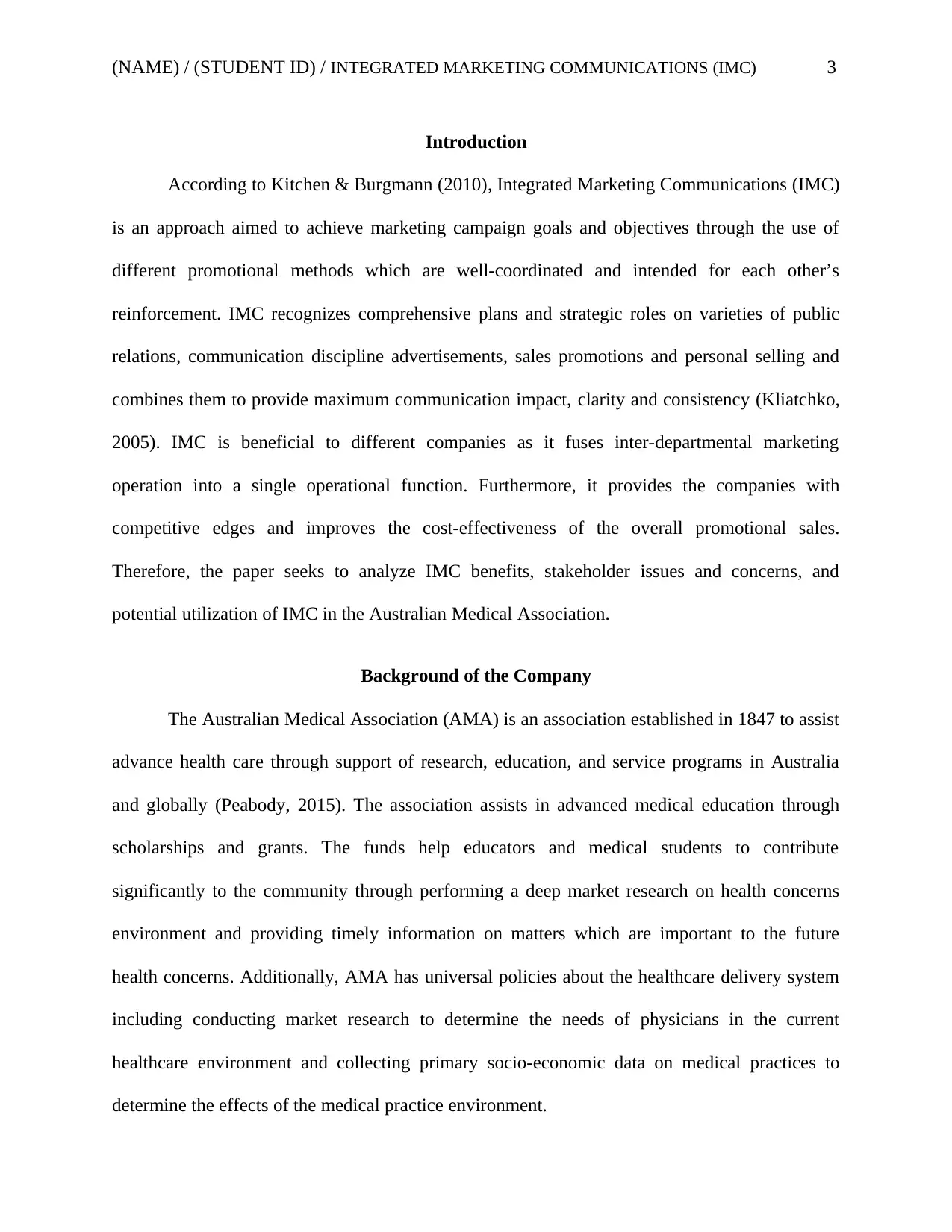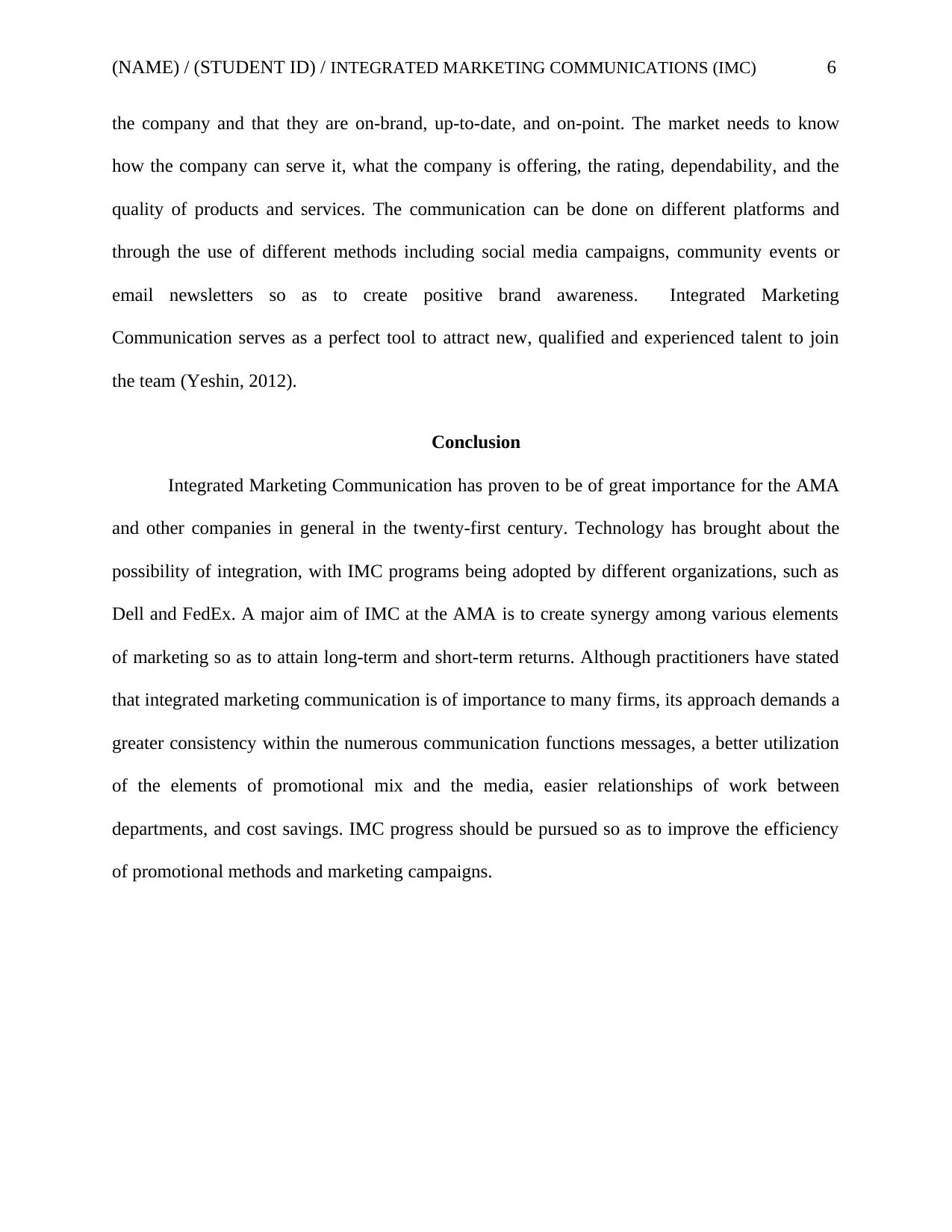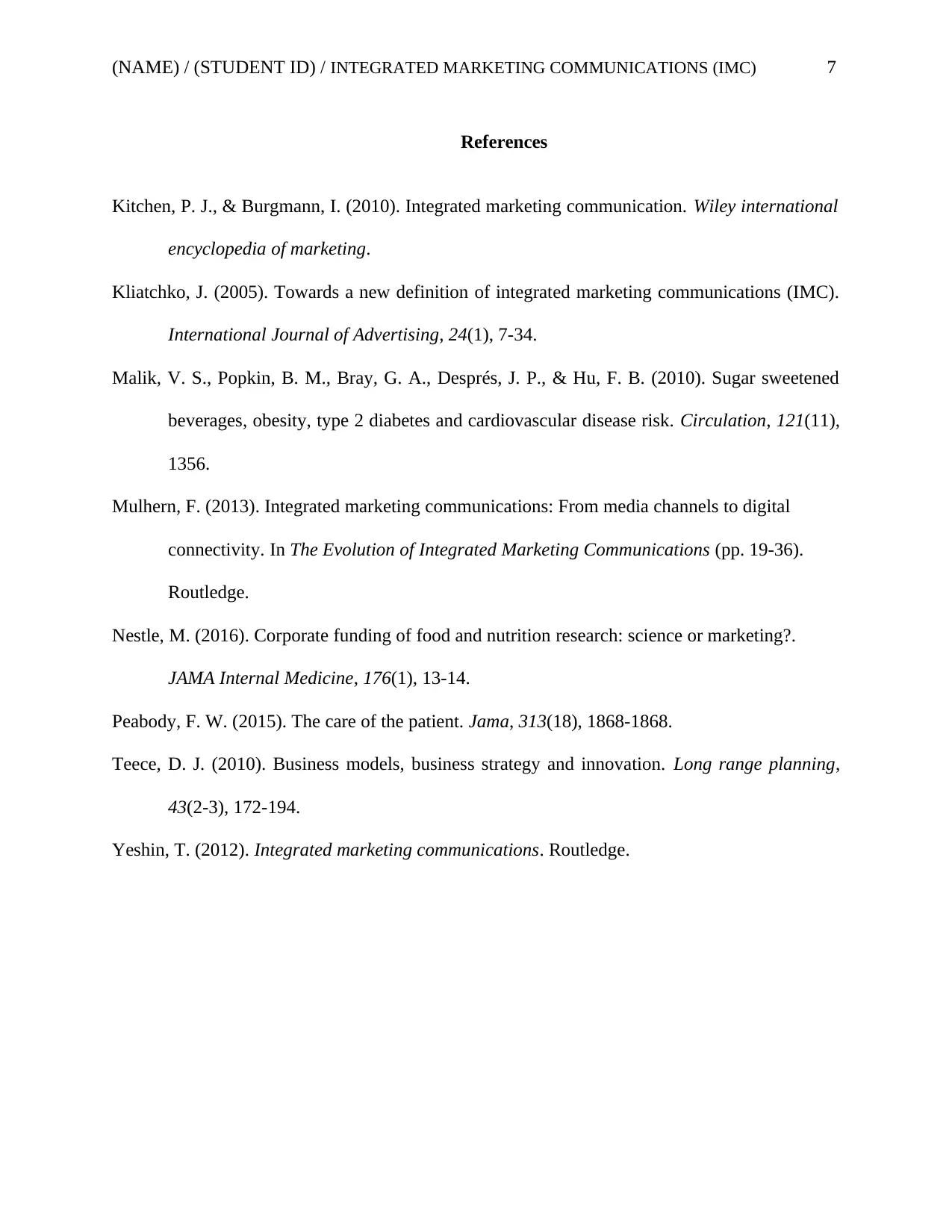Integrated Marketing Communications (IMC) for AMA: A Case Study
VerifiedAdded on 2023/06/08
|7
|1598
|314
Report
AI Summary
This report provides an in-depth analysis of the Integrated Marketing Communications (IMC) strategies employed by the Australian Medical Association (AMA). It begins with an introduction to IMC, defining its role in achieving marketing objectives through coordinated promotional methods. The report then provides background information on the AMA, highlighting its establishment and objectives in advancing healthcare through research, education, and service programs. A situation analysis examines the complexities of the market in which the AMA operates, particularly concerning the communication challenges related to initiatives like banning sugary products, considering factors such as multiple communication objectives, target audience complexity, and product distribution. The report identifies stakeholder issues and concerns, focusing on the complexities of organizational communication, the impact of decision-making processes, and the influence of product and distribution complexities on communication. Finally, the report explores the potential utilization and role of IMC in the overall marketing and business strategy of the AMA, emphasizing its importance in delivering cohesive messages across multiple channels to enhance sales, productivity, and brand presence. The report concludes by emphasizing the significance of IMC in the modern business environment and its potential to improve promotional methods and marketing campaigns.

Running Head: INTEGRATED MARKETING COMMUNICATIONS (IMC) 1
INTEGRATED MARKETING COMMUNICATIONS: A CASE OF THE AUSTRALIAN
MEDICAL ASSOCIATION
Name
Student ID
Assessment Number
Course Name
Unit Name
Topic
Institutional Affiliation
Submission Date
INTEGRATED MARKETING COMMUNICATIONS: A CASE OF THE AUSTRALIAN
MEDICAL ASSOCIATION
Name
Student ID
Assessment Number
Course Name
Unit Name
Topic
Institutional Affiliation
Submission Date
Paraphrase This Document
Need a fresh take? Get an instant paraphrase of this document with our AI Paraphraser

(NAME) / (STUDENT ID) / INTEGRATED MARKETING COMMUNICATIONS (IMC) 2
Table of Contents
Introduction....................................................................................................................................3
Background of the Company........................................................................................................3
Situation Analysis..........................................................................................................................4
Potential Utilization and Role of IMC in the Overall Marketing and Business Strategy.......5
Conclusion......................................................................................................................................6
References.......................................................................................................................................7
Table of Contents
Introduction....................................................................................................................................3
Background of the Company........................................................................................................3
Situation Analysis..........................................................................................................................4
Potential Utilization and Role of IMC in the Overall Marketing and Business Strategy.......5
Conclusion......................................................................................................................................6
References.......................................................................................................................................7

(NAME) / (STUDENT ID) / INTEGRATED MARKETING COMMUNICATIONS (IMC) 3
Introduction
According to Kitchen & Burgmann (2010), Integrated Marketing Communications (IMC)
is an approach aimed to achieve marketing campaign goals and objectives through the use of
different promotional methods which are well-coordinated and intended for each other’s
reinforcement. IMC recognizes comprehensive plans and strategic roles on varieties of public
relations, communication discipline advertisements, sales promotions and personal selling and
combines them to provide maximum communication impact, clarity and consistency (Kliatchko,
2005). IMC is beneficial to different companies as it fuses inter-departmental marketing
operation into a single operational function. Furthermore, it provides the companies with
competitive edges and improves the cost-effectiveness of the overall promotional sales.
Therefore, the paper seeks to analyze IMC benefits, stakeholder issues and concerns, and
potential utilization of IMC in the Australian Medical Association.
Background of the Company
The Australian Medical Association (AMA) is an association established in 1847 to assist
advance health care through support of research, education, and service programs in Australia
and globally (Peabody, 2015). The association assists in advanced medical education through
scholarships and grants. The funds help educators and medical students to contribute
significantly to the community through performing a deep market research on health concerns
environment and providing timely information on matters which are important to the future
health concerns. Additionally, AMA has universal policies about the healthcare delivery system
including conducting market research to determine the needs of physicians in the current
healthcare environment and collecting primary socio-economic data on medical practices to
determine the effects of the medical practice environment.
Introduction
According to Kitchen & Burgmann (2010), Integrated Marketing Communications (IMC)
is an approach aimed to achieve marketing campaign goals and objectives through the use of
different promotional methods which are well-coordinated and intended for each other’s
reinforcement. IMC recognizes comprehensive plans and strategic roles on varieties of public
relations, communication discipline advertisements, sales promotions and personal selling and
combines them to provide maximum communication impact, clarity and consistency (Kliatchko,
2005). IMC is beneficial to different companies as it fuses inter-departmental marketing
operation into a single operational function. Furthermore, it provides the companies with
competitive edges and improves the cost-effectiveness of the overall promotional sales.
Therefore, the paper seeks to analyze IMC benefits, stakeholder issues and concerns, and
potential utilization of IMC in the Australian Medical Association.
Background of the Company
The Australian Medical Association (AMA) is an association established in 1847 to assist
advance health care through support of research, education, and service programs in Australia
and globally (Peabody, 2015). The association assists in advanced medical education through
scholarships and grants. The funds help educators and medical students to contribute
significantly to the community through performing a deep market research on health concerns
environment and providing timely information on matters which are important to the future
health concerns. Additionally, AMA has universal policies about the healthcare delivery system
including conducting market research to determine the needs of physicians in the current
healthcare environment and collecting primary socio-economic data on medical practices to
determine the effects of the medical practice environment.
⊘ This is a preview!⊘
Do you want full access?
Subscribe today to unlock all pages.

Trusted by 1+ million students worldwide

(NAME) / (STUDENT ID) / INTEGRATED MARKETING COMMUNICATIONS (IMC) 4
Situation Analysis
The market in which AMA is operating has several factors that have contributed to the
complexity of the communication problems. The factors contributing to ICM problems when
seeking out to ban sugary products include multiple communication objectives, the complexity
of target audiences, product complexity, and distribution complexity of the products and
services. According to Malik et al. (2010) frequently consuming sugar-sweetened beverages
results in health concerns such as obesity, diabetes, and cardiovascular diseases. Despite
different health unions discouraging sugary products consumption due to its associated diseases,
many people are still consuming the products with IMC strategies increasing the sales of items.
AMA is seeking to implement IMC strategy that will convince the government to support
the organization as it seeks to ban the advertisement of junk food and sugary drinks or
introduction of tax on sugar as a way of discouraging and limiting sugary products consumption.
However, different companies producing the sugary commodities have criticized the idea due to
the belief that the ban could lead to low sales or even closure of companies. The target audience
is still stuck to the production of sugary commodities as different advertisements from the media
are marketing products in a manner that makes their company’s customers never to change their
preference. The product itself has been consumed for many years and the majority of people can
never be convinced to reduce its consumption. Therefore, the AMA is really facing a tough battle
with both internal and external stakeholders as it tries to integrate their marketing
communication and techniques that will end sugary commodities consumption in the country.
Stakeholder Issues and Concerns
According to Kitchen & Burgmann (2010) for an organization to integrate the
communication message in order to have an impact in the market, both internal and external
Situation Analysis
The market in which AMA is operating has several factors that have contributed to the
complexity of the communication problems. The factors contributing to ICM problems when
seeking out to ban sugary products include multiple communication objectives, the complexity
of target audiences, product complexity, and distribution complexity of the products and
services. According to Malik et al. (2010) frequently consuming sugar-sweetened beverages
results in health concerns such as obesity, diabetes, and cardiovascular diseases. Despite
different health unions discouraging sugary products consumption due to its associated diseases,
many people are still consuming the products with IMC strategies increasing the sales of items.
AMA is seeking to implement IMC strategy that will convince the government to support
the organization as it seeks to ban the advertisement of junk food and sugary drinks or
introduction of tax on sugar as a way of discouraging and limiting sugary products consumption.
However, different companies producing the sugary commodities have criticized the idea due to
the belief that the ban could lead to low sales or even closure of companies. The target audience
is still stuck to the production of sugary commodities as different advertisements from the media
are marketing products in a manner that makes their company’s customers never to change their
preference. The product itself has been consumed for many years and the majority of people can
never be convinced to reduce its consumption. Therefore, the AMA is really facing a tough battle
with both internal and external stakeholders as it tries to integrate their marketing
communication and techniques that will end sugary commodities consumption in the country.
Stakeholder Issues and Concerns
According to Kitchen & Burgmann (2010) for an organization to integrate the
communication message in order to have an impact in the market, both internal and external
Paraphrase This Document
Need a fresh take? Get an instant paraphrase of this document with our AI Paraphraser

(NAME) / (STUDENT ID) / INTEGRATED MARKETING COMMUNICATIONS (IMC) 5
stakeholders must have a big creative idea. The AMA board members and donors are concerned
about the complexity in the delivery and planning of the organizational communication. More
people getting involved in the planning process increases the communication task hence
increasing the complexity of the target audience. Generally, where one stakeholder takes over all
the decision making process roles, it is easier to communicate since only a single message that is
straightforward and intended for a single person is all that is required.
Increased involvement of people in the decision process creates the need for potentially
using a variety of media, integrated delivery systems, and multiple messages increases (Mulhem,
2013). In addition, the service or product complexity makes simple communication problems in
organizations to become complex, which can be even more if the product is innovative or
complex hence being a potential concern for stakeholders as they would require a more complex
communication method and one that usually requires a high involvement of decision makers.
Moreover, distribution complexity extends beyond promotions of trade with many delivery
systems having an impact on the decision of customers on choosing a particular brand. New
ways of organizational communication have been brought about by a hike in global marketing
hence contributing to the complexity of distribution and communication systems. The AMA
stakeholders should ensure that they are aware of the increase of foreign-based competitors even
if the company does not sell outside its native country.
Potential Utilization and Role of IMC in the Overall Marketing and Business Strategy
Integrated Marketing Communication delivers a company message which is cohesive
across multiple channels to enhance sales, productivity, and for the company’s overall presence
to be felt in the market by the Australian Medical Association (Nestle, 2016). As the company’s
voice, IMC ensures that all messages communicated by the company align with the objectives of
stakeholders must have a big creative idea. The AMA board members and donors are concerned
about the complexity in the delivery and planning of the organizational communication. More
people getting involved in the planning process increases the communication task hence
increasing the complexity of the target audience. Generally, where one stakeholder takes over all
the decision making process roles, it is easier to communicate since only a single message that is
straightforward and intended for a single person is all that is required.
Increased involvement of people in the decision process creates the need for potentially
using a variety of media, integrated delivery systems, and multiple messages increases (Mulhem,
2013). In addition, the service or product complexity makes simple communication problems in
organizations to become complex, which can be even more if the product is innovative or
complex hence being a potential concern for stakeholders as they would require a more complex
communication method and one that usually requires a high involvement of decision makers.
Moreover, distribution complexity extends beyond promotions of trade with many delivery
systems having an impact on the decision of customers on choosing a particular brand. New
ways of organizational communication have been brought about by a hike in global marketing
hence contributing to the complexity of distribution and communication systems. The AMA
stakeholders should ensure that they are aware of the increase of foreign-based competitors even
if the company does not sell outside its native country.
Potential Utilization and Role of IMC in the Overall Marketing and Business Strategy
Integrated Marketing Communication delivers a company message which is cohesive
across multiple channels to enhance sales, productivity, and for the company’s overall presence
to be felt in the market by the Australian Medical Association (Nestle, 2016). As the company’s
voice, IMC ensures that all messages communicated by the company align with the objectives of

(NAME) / (STUDENT ID) / INTEGRATED MARKETING COMMUNICATIONS (IMC) 6
the company and that they are on-brand, up-to-date, and on-point. The market needs to know
how the company can serve it, what the company is offering, the rating, dependability, and the
quality of products and services. The communication can be done on different platforms and
through the use of different methods including social media campaigns, community events or
email newsletters so as to create positive brand awareness. Integrated Marketing
Communication serves as a perfect tool to attract new, qualified and experienced talent to join
the team (Yeshin, 2012).
Conclusion
Integrated Marketing Communication has proven to be of great importance for the AMA
and other companies in general in the twenty-first century. Technology has brought about the
possibility of integration, with IMC programs being adopted by different organizations, such as
Dell and FedEx. A major aim of IMC at the AMA is to create synergy among various elements
of marketing so as to attain long-term and short-term returns. Although practitioners have stated
that integrated marketing communication is of importance to many firms, its approach demands a
greater consistency within the numerous communication functions messages, a better utilization
of the elements of promotional mix and the media, easier relationships of work between
departments, and cost savings. IMC progress should be pursued so as to improve the efficiency
of promotional methods and marketing campaigns.
the company and that they are on-brand, up-to-date, and on-point. The market needs to know
how the company can serve it, what the company is offering, the rating, dependability, and the
quality of products and services. The communication can be done on different platforms and
through the use of different methods including social media campaigns, community events or
email newsletters so as to create positive brand awareness. Integrated Marketing
Communication serves as a perfect tool to attract new, qualified and experienced talent to join
the team (Yeshin, 2012).
Conclusion
Integrated Marketing Communication has proven to be of great importance for the AMA
and other companies in general in the twenty-first century. Technology has brought about the
possibility of integration, with IMC programs being adopted by different organizations, such as
Dell and FedEx. A major aim of IMC at the AMA is to create synergy among various elements
of marketing so as to attain long-term and short-term returns. Although practitioners have stated
that integrated marketing communication is of importance to many firms, its approach demands a
greater consistency within the numerous communication functions messages, a better utilization
of the elements of promotional mix and the media, easier relationships of work between
departments, and cost savings. IMC progress should be pursued so as to improve the efficiency
of promotional methods and marketing campaigns.
⊘ This is a preview!⊘
Do you want full access?
Subscribe today to unlock all pages.

Trusted by 1+ million students worldwide

(NAME) / (STUDENT ID) / INTEGRATED MARKETING COMMUNICATIONS (IMC) 7
References
Kitchen, P. J., & Burgmann, I. (2010). Integrated marketing communication. Wiley international
encyclopedia of marketing.
Kliatchko, J. (2005). Towards a new definition of integrated marketing communications (IMC).
International Journal of Advertising, 24(1), 7-34.
Malik, V. S., Popkin, B. M., Bray, G. A., Després, J. P., & Hu, F. B. (2010). Sugar sweetened
beverages, obesity, type 2 diabetes and cardiovascular disease risk. Circulation, 121(11),
1356.
Mulhern, F. (2013). Integrated marketing communications: From media channels to digital
connectivity. In The Evolution of Integrated Marketing Communications (pp. 19-36).
Routledge.
Nestle, M. (2016). Corporate funding of food and nutrition research: science or marketing?.
JAMA Internal Medicine, 176(1), 13-14.
Peabody, F. W. (2015). The care of the patient. Jama, 313(18), 1868-1868.
Teece, D. J. (2010). Business models, business strategy and innovation. Long range planning,
43(2-3), 172-194.
Yeshin, T. (2012). Integrated marketing communications. Routledge.
References
Kitchen, P. J., & Burgmann, I. (2010). Integrated marketing communication. Wiley international
encyclopedia of marketing.
Kliatchko, J. (2005). Towards a new definition of integrated marketing communications (IMC).
International Journal of Advertising, 24(1), 7-34.
Malik, V. S., Popkin, B. M., Bray, G. A., Després, J. P., & Hu, F. B. (2010). Sugar sweetened
beverages, obesity, type 2 diabetes and cardiovascular disease risk. Circulation, 121(11),
1356.
Mulhern, F. (2013). Integrated marketing communications: From media channels to digital
connectivity. In The Evolution of Integrated Marketing Communications (pp. 19-36).
Routledge.
Nestle, M. (2016). Corporate funding of food and nutrition research: science or marketing?.
JAMA Internal Medicine, 176(1), 13-14.
Peabody, F. W. (2015). The care of the patient. Jama, 313(18), 1868-1868.
Teece, D. J. (2010). Business models, business strategy and innovation. Long range planning,
43(2-3), 172-194.
Yeshin, T. (2012). Integrated marketing communications. Routledge.
1 out of 7
Related Documents
Your All-in-One AI-Powered Toolkit for Academic Success.
+13062052269
info@desklib.com
Available 24*7 on WhatsApp / Email
![[object Object]](/_next/static/media/star-bottom.7253800d.svg)
Unlock your academic potential
Copyright © 2020–2025 A2Z Services. All Rights Reserved. Developed and managed by ZUCOL.





